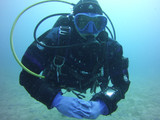Snorkeling: The do's and don'ts of skin diving
Snorkeling seems easy and simple. Throw on a mask and snorkel and get in the water. It can be that simple if you follow a few important rules.



Do's
1. Get good gear and practice with it. There is nothing worse than getting to your vacation destination and realizing that you are missing a key piece of gear or that it does not fit. Before you go on your trip invest in high quality equipment.
Mask-Look for a mask with high grade silicone, this is softer and holds a seal on your face better and more comfortably. Make sure your mask is made with tempered safety glass, this will last longer and less foggy.
Snorkel-Find a snorkel with high grade silicone on the mouthpiece for your comfort. Check the clip for attaching to a mask it is best that the snorkel can be easily removed and added to the mask without being to easy that it might fall off.
Fins-Fin styles and sizes range as much as shoes. Whichever you chose try them on your feet, one size fits all doesn't really exist. Look for a a snug fit that will not fall off easily but does not cramp your foot or cut off circulation. Some fins require a beach shoe, wet suit boot or water sock to be worn with the fin.
Snorkeling vest(flotation)- Mandatory with many snorkel boats or tours and optional for personal use. Best for those who are not strong swimmers or comfortable in the water. Snorkel vests unlike a PFD or life jackets allow the swimmer to float at the surface while laying face down in the water.
Take your snorkel gear to a local pool or lake(in the summer) and get comfortable. Snorkel lessons are also available to give you a little professional help. Learn to adjust the mask and fins. Get your muscles used to kicking with the fins.
2. Always snorkel with a buddy or group. You never know when trouble can strike and having a little help can make all the difference. For advanced snorkelers that are diving down and holding their breathe there should always be another snorkeler at the surface in case of shallow water blackouts.
Not to mention snorkeling is always more fun when you have someone to share it with.
3. Cover up. Sunburn is the most common injury for snorkelers. Many sunscreens are not safe for the marine life and should not be worn in the water. The best thing to protect your skin is to cover up with a wet suit or rash guard. Rash guards also called sun shirts typically have an SPF of 50 and can offer protection from jellyfish, scrapes and abrasions as well. Wet suits will provide sun protection and thermal protection. Perfect for those who get cold easily or those who would like to stay out in the water for longer periods of time.

Don'ts
1. Do not touch anything. When it comes to fragile and dangerous marine life just remember, if you aren't hurting it it might be hurting you!
2. Don't swim with your hands. Swimming with your hands is far less efficient then using your fins to propel you. It also makes you more likely to smack your buddy or the coral.
3. Don't forget to know your environment. Check the weather forecast, be aware of local currents and local laws. Park passes may be required while in marine parks.
Recent Posts
-
Scuba Refresher Courses: Why They’re Essential for Every Diver
If you take a look at your scuba certification card, you’ll notice there’s no expiration date. …2025 Apr 7th -
Local Scuba Diving Available During the Summer
Fresh water diving is available all summer and into the fall in various lakes around the province …2024 May 29th -
Top 5 reasons to start Snorkeling
There are so many reasons to go on a nice, warm, tropical vacation during the winter, especially her …2024 Mar 7th




